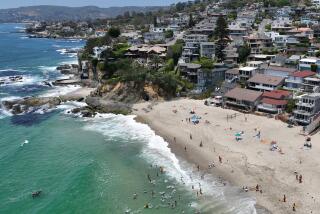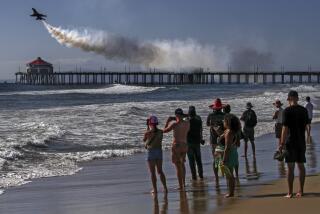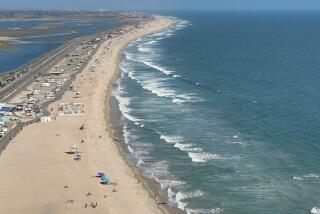Surf City’s Holiday Dilemma
- Share via
A debate over fireworks has left civic leaders wondering whether downtown Huntington Beach has truly put its uncivil ways behind it.
The beach town has had a long history of Fourth of July violence, and memories of the summer nights when police squad cars were set ablaze and officers were pummeled with firecrackers have not faded.
The memories are strong enough that a proposal to bring the town’s annual fireworks show back to the shoreline this year was snuffed by city officials who feared it might reignite a riotous past.
But fireworks fans say the wild and reckless behavior that once defined downtown during the holiday is a thing of the past. The area has matured, they say, and is ready for a second chance at a slice of Americana enjoyed by beach cities up and down the coast.
The proposal, which the City Council recently rejected on a 4-1 vote, has kindled a debate over the identity of downtown Huntington Beach, an area once dominated by surfers but now being redeveloped with an older crowd in mind.
Advocates of resuming the aerial display say the gentrified downtown now draws families as well as youth and that a strong police presence with zero tolerance for unruly behavior has kept violence in check for several years running. Others worry that downtown Huntington Beach still isn’t ready.
The beach fireworks display was moved a couple of miles inland to a high school football stadium in the mid-1970s after city officials agreed that the pyrotechnics added an element of danger that downtown could no longer handle. Even without the fireworks, the zone entered an era of Independence Day violence with police marching in riot gear and makeshift jails set up along the beach. . As recently as five years ago, more than 500 people were arrested.
Over the years, downtown Huntington Beach has undergone several changes in character. In the ‘30s and ‘40s it was a vibrant but small community and Independence Day on the beach was easygoing and fun.
Old-timers remember the cozy nights as the fireworks’ bright bursts of color were reflected on the shimmering ocean.
Alicia Wentworth, 75, the city’s historian, moved to town in 1947 and recalls an intimacy to the holiday that faded as the crowds grew bigger.
“We were very small, about 5,000 people. Everybody was able to sit on the beach and watch the fireworks. It was just home folk,” said Wentworth. “They were simple fireworks but they were still awesome to us. It was beautiful.”
But as the city grew--and with it the surf subculture that shaped downtown--so did the popularity of the festivities on the beach. By the ‘70s, the beach crowd appeared to have more control of the area than the police. By the ‘90s, even with the beach fireworks display long gone, downtown was an area under siege when the holiday rolled around. Hundreds of city police, sheriff’s deputies and Highway Patrol officers roamed the streets, rounding up revelers by the score. But that was then and this is now, said Mayor Debbie Cook, the only City Council member who favored resuming fireworks at the beach.
“Don’t write it off because there was a problem in the past,” Cook said. “It’s different now and the people who go to see the fireworks are much more of a family crowd. As the city matures, it should be given another opportunity to have a fireworks display at the beach.”
The area has changed, but the question remains whether it has changed enough.
“It still tends to attract youth and attracts them from all over,” said Bob Mandic, a former councilman and owner of Mandic Motors a few blocks up Main Street from Pacific Coast Highway. “There’s a lot of good people out there, but there’s the 1% who make it bad for everyone else.”
The surf culture is still in play downtown, with shops such as Jack’s Surfboards, Sokal Surfboards and Rockin’ Fig Surf Headquarters. Wetsuit-clad surfers saunter up and down the street. Posters advertising surf contests are plastered on shop windows.
But coffee shops such as Java Point at Pacific Coast Highway and Main, and restaurants such as Duke’s and Chimayo’s Tropical Grill in a city-owned building at the foot of the pier, point to a steady transformation from a scruffy surfer hangout to a family destination.
New complexes, such as Pierside Pavilion, Oceanview Promenade and Main Promenade, account for nearly 100,000 square feet of office and retail space that rakes in $166,000 a year in sales tax revenue.
Those projects, along with the Waterfront Hilton Beach Resort, and a Hyatt Regency Resort and Conference Center under construction, signal a “new Huntington Beach,” said Jennifer Wise, a real estate agent who does business downtown.
Wise said the city gets “a bum rap” over the past violence and points to the family flavor of the annual Independence Day parade down Main Street, which last year was extended down Pacific Coast Highway to accommodate spectators.
“There’s never any problems with the parade,” Wise said.
Connie Young, spokeswoman for the Fourth of July Executive Board, which organizes the festivities, said the group took stock of downtown’s changes and felt it was time to bring the fireworks back to the beach. The group had hoped that this year--with patriotism running high--it would be possible to return to the beach with a larger aerial display. .
The high school stadium where the fireworks display was moved holds about 5,000 people. Admission is $6 and the event sells out quickly. At least 50,000 people could fit on the beachfront near downtown. Other beach cities in the county put on Fourth of July fireworks and violence has been minimal. In San Clemente, for instance, 16,000 people typically head to the sand for the show.
“That’s as packed as San Clemente can take,” said Richard Chew, a lifeguard supervisor who says he usually spends the Fourth at a friend’s house high in the canyons above Laguna Beach, where he can see fireworks arcing into the sky from Emerald Bay, Monarch Bay, Dana Point Harbor and San Clemente.
The Fire Department sees an advantage to moving the fireworks from the stadium to the shore. Police, though, say the beach presents crowd control problems and that in a stadium setting they can check bags and knapsacks for illegal fireworks and alcohol.
“I see [the proposal] as just asking for unruly behavior problems in downtown,” said Councilwoman Connie Boardman. “Also, a lot of the parking will not be available, and inviting tens of thousands of people down to the beach and not give them a place to park would create tons of problems.”
Boardman also said the city would lose about $20,000 a year in stadium ticket sales while spending about $65,000 for additional police protection.
“I just don’t want to do something that would provide a return to past problems,” she said.
More to Read
Sign up for Essential California
The most important California stories and recommendations in your inbox every morning.
You may occasionally receive promotional content from the Los Angeles Times.













